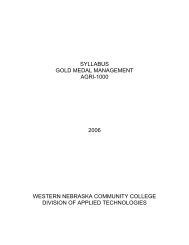View Current Syllabus - Western Nebraska Community College
View Current Syllabus - Western Nebraska Community College
View Current Syllabus - Western Nebraska Community College
You also want an ePaper? Increase the reach of your titles
YUMPU automatically turns print PDFs into web optimized ePapers that Google loves.
EMT-INTERMEDIATE 1-B<br />
EMTL-2220<br />
Behavioral Objectives<br />
decompensated hemorrhagic shock.<br />
14. Discuss the management of internal<br />
hemorrhage.<br />
15. Define shock based on aerobic and<br />
anerobic metabolism.<br />
16. Describe the incidence, morbidity, and<br />
mortality of shock.<br />
17. Describe the body’s physiologic<br />
response to changes in perfusion.<br />
18. Describe the effects of decreased<br />
perfusion at the capillary level.<br />
19. Discuss the cellular ischemic phase<br />
related to hemorrhagic shock.<br />
20. Discuss the capillary stagnation phase<br />
related to hemorrhagic shock.<br />
21. Discuss the capillary washout phase<br />
related to hemorrhagic shock.<br />
22. Discuss the assessment findings of<br />
hemorrhagic shock.<br />
23. Relate pulse pressure changes to<br />
perfusion status.<br />
24. Relate orthostatic vital sign changes<br />
to perfusion status.<br />
25. Define compensated and<br />
decompensated shock.<br />
26. Discuss pathophysiological changes<br />
associated with compensated shock.<br />
27. Discus the assessment findings<br />
associated with compensated shock.<br />
28. Identify the need for intervention and<br />
transport to the patient with compensated<br />
shock.<br />
29. Discuss the treatment plan and<br />
management of compensated shock.<br />
30. Discuss the pathophysiological<br />
changes associated with decompensated<br />
shock.<br />
31. Discuss the assessment findings<br />
associated with decompensated shock.<br />
32. Identify the need for intervention and<br />
transport of the patient with<br />
Skills Lab Objectives<br />
hemorrhage.<br />
Demonstrate the management of a patient<br />
with signs and symptoms of internal<br />
hemorrhage.<br />
Demonstrate the assessment of a patient<br />
with signs and symptoms of compensated<br />
hemorrhagic shock.<br />
Demonstrate the management of a patient<br />
with signs and symptoms of compensated<br />
hemorrhagic shock.<br />
Demonstrate the assessment of a patient<br />
with signs and symptoms of<br />
decompensated hemorrhagic shock.<br />
8
















